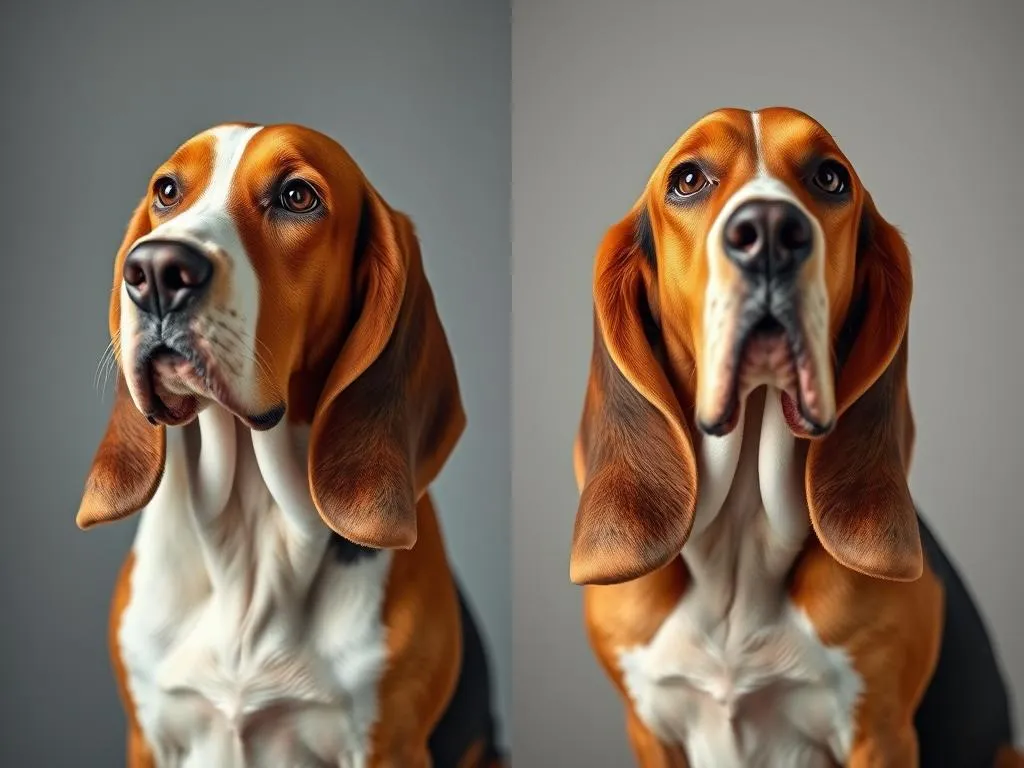
Introduction
The Basset Hound is a beloved breed known for its droopy ears, soulful expression, and exceptional sense of smell. As a breed with a rich history and a distinctive appearance, Basset Hounds have captured the hearts of dog lovers around the world. Understanding the differences between male and female Basset Hounds can significantly enhance your experience as a dog owner. This article delves into the characteristics, behaviors, and health considerations of both male and female Basset Hounds, equipping you with the knowledge to make an informed decision.
Understanding the Basset Hound Breed
History and Origin
The Basset Hound originated in France, where it was bred primarily for hunting small game such as rabbits and hares. Its name “Basset” derives from the French word “bas,” meaning low, which aptly describes its short stature. This breed was developed from the Bloodhound and other hounds, boasting an impressive sense of smell, making it a reliable hunting companion. Over the years, Basset Hounds transitioned from working dogs to affectionate companions, celebrated for their gentle nature and loyalty.
Physical Characteristics
Basset Hounds are easily recognizable by their unique physical attributes. They typically weigh between 40 to 65 pounds and stand about 14 to 15 inches tall at the shoulder. Their long, droopy ears and loose, wrinkled skin give them a distinctive appearance. The breed’s body is low to the ground, with a sturdy build and a short, straight back. Their strong legs and large paws contribute to their ability to navigate various terrains during hunts.
General Temperament of Basset Hounds
Common Traits
Known for their friendly and sociable nature, Basset Hounds often get along well with other pets and children. They are typically laid-back and enjoy spending time with their families, making them excellent companions. Their affectionate disposition means they thrive on human interaction, often forming strong bonds with their owners.
Intelligence and Trainability
While Basset Hounds possess a certain level of intelligence, they are known for being somewhat stubborn. This breed can challenge even the most patient trainers, as they often follow their noses rather than commands. Consistent, positive reinforcement training methods work best, and early socialization is crucial for well-rounded behavior.
Male Basset Hounds: Characteristics and Traits
Physical Attributes
Male Basset Hounds are generally larger than their female counterparts, typically weighing between 50 to 65 pounds. They have a slightly more robust build, with broader heads and thicker necks. Their physical presence gives them a more masculine appearance, which some dog owners may prefer depending on their lifestyle and aesthetic preferences.
Temperament and Behavior
Male Basset Hounds are often playful and energetic, displaying a spirited personality that can be contagious. They may exhibit more stubbornness and independence than females, which can lead to challenges in training. However, their affectionate nature makes them loving companions. Males may also be more prone to marking their territory, especially if not neutered.
Health Considerations
In terms of health, male Basset Hounds are subject to specific issues such as hip dysplasia, ear infections, and obesity. Regular vet check-ups and a controlled diet are essential to ensuring their well-being. The average lifespan for male Basset Hounds is about 10 to 12 years, so proactive health management can help them enjoy a longer, healthier life.
Female Basset Hounds: Characteristics and Traits
Physical Attributes
Female Basset Hounds typically weigh between 40 to 60 pounds, making them slightly smaller and lighter than males. They possess a more delicate appearance, with a narrower head and a gentler expression. The subtle differences in size and structure can influence the choice between male and female for potential dog owners.
Temperament and Behavior
Female Basset Hounds tend to be more nurturing and sensitive, often displaying strong motherly instincts. They may be more prone to forming deep attachments with their families and often possess a calmer demeanor compared to males. Though still playful, females may not exhibit the same level of rambunctiousness as males, making them suitable for quieter households.
Health Considerations
Female Basset Hounds face specific health issues, including complications related to pregnancy and spaying. Like males, they are also prone to hip dysplasia and obesity. Ensuring a healthy diet and regular exercise is crucial. The average lifespan for female Basset Hounds is similar to that of males, around 10 to 12 years, but they may have a slightly longer life expectancy due to lower rates of certain health issues.
Male vs Female Basset Hounds: Key Comparisons
Size and Weight
When comparing the male vs female Basset Hound, the most noticeable difference lies in their size and weight. Males generally weigh more and have a sturdier build, while females are smaller and lighter. This difference may be a deciding factor for potential owners looking for a specific type of companion.
Behavioral Differences
In terms of behavior, male Basset Hounds may exhibit more playfulness and energy, while females tend to be calmer and more nurturing. Males can be more stubborn, leading to challenges in training, whereas females may respond better to commands due to their sensitive nature. Understanding these differences can guide potential owners in choosing the right fit for their lifestyle.
Trainability and Intelligence
Both male and female Basset Hounds can be trained, but their trainability can vary. Males may be more independent and stubborn, requiring a patient approach to training. Females, on the other hand, often demonstrate a willingness to please, making them slightly more manageable during training sessions. Individual temperament plays a significant role in their success, regardless of gender.
Grooming and Care
Grooming needs for both male and female Basset Hounds are similar, requiring regular brushing to manage shedding and maintain their coat’s health. However, males may require more attention to ear hygiene due to their larger ears, which can trap moisture and lead to infections. Health care considerations are also comparable, with both genders needing regular vet visits and a balanced diet.
Choosing Between a Male or Female Basset Hound
Personal Lifestyle Considerations
Your personal lifestyle can significantly influence the decision between a male or female Basset Hound. If you lead an active lifestyle, a male may provide the playful energy you desire. Conversely, if you prefer a more subdued environment, a female might be the better choice, given her typically calmer demeanor.
Family Dynamics
Family dynamics also play a crucial role in the decision-making process. If you have young children or other pets, a female Basset Hound may be more suitable due to her nurturing instincts. Males can also be great with kids, but understanding their more boisterous nature is essential for ensuring harmonious interactions.
Future Considerations
Consider your future plans when choosing between a male or female Basset Hound. If you are contemplating breeding, a female may be more appropriate. Additionally, decisions regarding spaying or neutering should be considered, as these procedures can influence health, behavior, and training outcomes.
Conclusion
In summary, the choice between a male vs female Basset Hound hinges on various factors, including physical characteristics, temperament, and individual lifestyle considerations. While males tend to be more playful and larger, females often display nurturing qualities and a calmer demeanor. Ultimately, it’s crucial to prioritize individual personalities over gender when selecting a Basset Hound. With their affectionate nature and loyalty, both male and female Basset Hounds can make wonderful companions, enriching your life for years to come.









